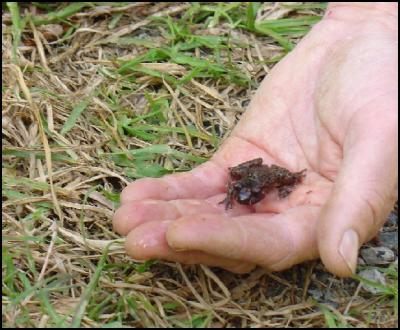Hochstetter frog relocated
Transit New Zealand
Auckland Regional Office
08
November 2004
Hochstetter frog
relocated

Transit New Zealand and the Department of Conservation have successfully undertaken the relocation of the native Hochstetter frog from a road work site in the Brynderwyn Hills north of Auckland.
Transit is due to begin work to increase safety on an 80m section of State Highway 1 where a slip has occurred on Pilbrow Hill in the Brynderwyns. A buttress filler will be used to support the road with work starting today and continuing until December.
A team of DoC workers searched for the frog since Labour weekend, and continued through to Sunday 7 November. A total of 28 frogs were found, identified and relocated.
The Hochstetter frog is one of only four indigenous frogs, and has been here over 80 million years, which is as old as New Zealand itself. Although the species is small (35-45mm) they have almost no natural predators as they secrete a noxious liquid from their skin. The Hochstetter frog's populations are found from Taranaki in the south to just north of the Brynderwyns at the Waipu caves.
Some of the frogs live in a stream adjacent to the area of road affected and DoC has searched and removed frogs up to 100 metres from the road. They have moved the frogs upstream to surrounding valleys and gullies within 500 metres of their current location. The frogs, if moved too far, may attempt to migrate back to their original habitat.
Upon completion of work, vegetation will be reintroduced and an attempt will be made to re-create their rocky habitat. This will allow the frogs access to travel back to re-inhabit the area. DoC will continue to monitor the area and take the opportunity for further learning of the species.
At the same time,
Transit contractors will be monitoring the drainage medium
to ensure that the Hochstetter frog will be able to utilise
the new habitat.
Local iwi Te Uri o Hau have worked in
co-operation with Transit and DOC and given blessing for the
relocation.
Disruption to motorists has been kept to a minimum as a result of the road works, with the contractors working on the side of the road away from traffic.
ENDS


 Gordon Campbell: On The Hikoi Aftermath
Gordon Campbell: On The Hikoi Aftermath Stats NZ: National Population Estimates: At 30 September 2024 (2018-base)
Stats NZ: National Population Estimates: At 30 September 2024 (2018-base) NZ Government: New Zealand’s COP29 National Statement
NZ Government: New Zealand’s COP29 National Statement Surf Life Saving NZ: Volunteer Lifeguards Make Big Effort To Keep Us Safe, As Paid Lifeguard Service Commences In Northern Region
Surf Life Saving NZ: Volunteer Lifeguards Make Big Effort To Keep Us Safe, As Paid Lifeguard Service Commences In Northern Region Action Station: Biggest Ever Community Petition, With Over 200,000 Signatures, Opposes Treaty Principles Bill
Action Station: Biggest Ever Community Petition, With Over 200,000 Signatures, Opposes Treaty Principles Bill Palestinians for Hīkoi mō te Tiriti: Statement From Palestinian Leaders - Hīkoi Mō Te Tiriti Is A Historic Moment For All In Aotearoa
Palestinians for Hīkoi mō te Tiriti: Statement From Palestinian Leaders - Hīkoi Mō Te Tiriti Is A Historic Moment For All In Aotearoa Anglican Church in Aotearoa: Anglican Archbishops To Join Hīkoi Mō Te Tiriti In Wellington
Anglican Church in Aotearoa: Anglican Archbishops To Join Hīkoi Mō Te Tiriti In Wellington


